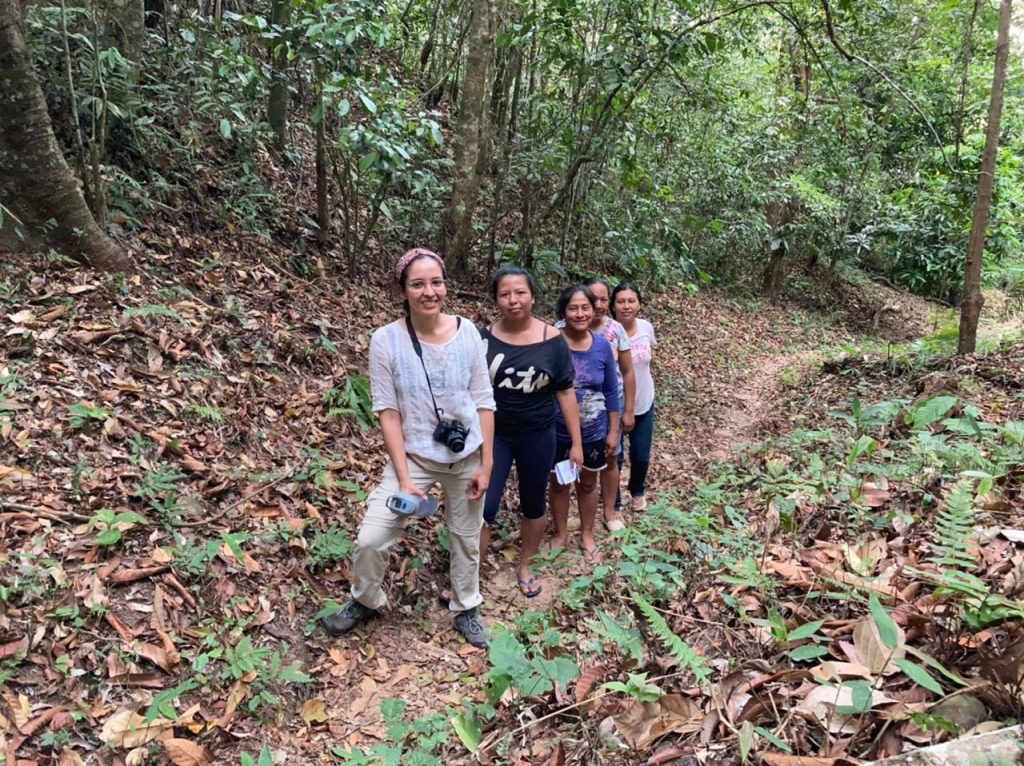What did IUCN NL do in 2024? Read…
17 April, 2025
Tuesday 09 august 2022
Header photo: Indigenous woman shows a cashew nut tree in San Jose de Uchupiamomas, Bolivia © Mariel Cabero/ IUCN NL
Indigenous peoples and local communities play an important role in the governance, conservation and sustainable use of the world’s biodiversity and nature, including tropical forests.
It is estimated that Indigenous peoples and local communities (IPLCs) are conserving at least 22 percent of the world’s Key Biodiversity Areas and at least 21 percent of the world’s lands- this is approximately the size of Africa[1]ICCA Consortium, 2021. Territories of Life: 2021 Report. Executive Summary. ICCA Consortium: worldwide. Available at: https://report.territoriesoflife.org/.
IPLCs’ lands and territories also cover at least one-third of intact forest landscapes globally[2]Fa, J. E., Watson, J. E., Leiper, I., Potapov, P., Evans, T. D., Burgess, N. D., … & Garnett, S. T. (2020). Importance of Indigenous Peoples’ lands for the conservation of Intact Forest … Continue reading and nearly one-third of areas that are considered key to reversing biodiversity loss, preventing CO2 emissions from land use change and enhancing natural carbon sinks[1].
Indigenous and Community Conserved Areas (ICCAs) are the territories and areas that are conserved by indigenous peoples and local communities. The concept was mainly coined by IUCN and has been formally recognized in international biodiversity governance since 2008.
It is not yet know exactly how many ICCAs there are globally, but organizations like the ICCA Registry are supporting communities to register their ICCAs so we can better articulate the significant role played by IPLCs in conserving nature.
If potential ICCAs were recognised for their contributions to conservation alongside the existing state and private protected and conserved area network (14% of the world’s land), the total coverage of protected areas would increase to 31%[3]https://report.territoriesoflife.org/global-analysis/.
Many Indigenous communities live in highly biodiverse areas, where living in balance with nature is key for survival. They have a strong connection to their territories and apply Indigenous knowledge systems and practices to protect, govern and use natural resources in these areas.
Because Indigenous peoples’ livelihoods and culture are dependent on nature, they have developed their own governance systems and practices to conserve their territories, since these are strongly linked with their identity. The traditional management of these areas, using Indigenous knowledge and practices, has proved to be sustainable. As a result, ecosystems and species on Indigenous managed territories are often less degraded than others[4]Sze, J.S., Carrasco, L.R., Childs, D. et al. Reduced deforestation and degradation in Indigenous Lands pan-tropically. Nat Sustain 5, 123–130 (2022). https://doi.org/10.1038/s41893-021-00815-2.
Indigenous women play a key role as environmental defenders. Because of their inseparable relation with their territories, Indigenous women are often at the frontline of defending their land against extractive activities such as oil exploration and mining.
They are also essential for their households and communities ‘food production, gathering medicinal plants and water and the sustainable use of natural resources. They also safeguard and transfer much of the traditional knowledge about nature.
Indigenous Peoples and their knowledge are already negatively impacted by the loss of biodiversity. When forests are cleared for expanding agricultural or mining activities, this often happens at the expense of the territory and rights of IPLCS.
Additionally, the cultural heritage of Indigenous Peoples is under threat. Traditional harvesting and archaeological and cultural heritage sites are being lost, as well as less tangible heritage like festivities and rites associated with natural cycles and sacred places, and their knowledge of nature and unique insights about plants and animals. These losses can have major impacts on cultural diversity and Indigenous knowledge systems, food security, health, and livelihoods, often with irreparable damage and consequences[5]Technical Summary. [H.-O. Pörtner, D.C. Roberts, E.S. Poloczanska, K. Mintenbeck, M. Tignor, A. Alegría, M. Craig, S. … Continue reading.
Despite their crucial role in addressing the climate and biodiversity crises, Indigenous Peoples’ land and forest management has received a small share of international donor funding over the last ten years — only an average of $270 million per year. This is less than one percent of Official Development Assistance (ODA) for climate change mitigation and adaptation [6]Rainforest Foundation Norway (2020). Falling short: Donor funding for Indigenous Peoples and local communities to secure tenure rights and manage forests in tropical countries (2011–2020). … Continue reading.
According to the Rainforest Foundation Norway, NGO intermediaries can play an important role in getting funds to IPLCs and in “buffering” the requirements of donors. At IUCN NL we have learned that when giving, sometimes even small, funds to IPLCs these are very efficiently managed. Finding the balance between flexibility and accountability is possible.
Mariel Cabero, expert Environmental Justice at IUCN NL explains: ‘For example, we have offered small grants to Indigenous women so they can directly manage the funds according to their needs (e.g. hire a lawyer, rent a space for meetings, IT equipment). We saw that when providing this direct support, especially in emergency cases, it is quickly allocated where it should be and that IPLCs are not just passive capacity building receivers but they are great at managing and administering project funding. We hope to continue learning and finding ways to better reach IPLCs at local level.’


| ↑1 | ICCA Consortium, 2021. Territories of Life: 2021 Report. Executive Summary. ICCA Consortium: worldwide. Available at: https://report.territoriesoflife.org/ |
|---|---|
| ↑2 | Fa, J. E., Watson, J. E., Leiper, I., Potapov, P., Evans, T. D., Burgess, N. D., … & Garnett, S. T. (2020). Importance of Indigenous Peoples’ lands for the conservation of Intact Forest Landscapes. Frontiers in Ecology and the Environment, 18(3), 135-140. https://esajournals.onlinelibrary.wiley.com/doi/full/10.1002/fee.2148 |
| ↑3 | https://report.territoriesoflife.org/global-analysis/ |
| ↑4 | Sze, J.S., Carrasco, L.R., Childs, D. et al. Reduced deforestation and degradation in Indigenous Lands pan-tropically. Nat Sustain 5, 123–130 (2022). https://doi.org/10.1038/s41893-021-00815-2 |
| ↑5 | Technical Summary. [H.-O. Pörtner, D.C. Roberts, E.S. Poloczanska, K. Mintenbeck, M. Tignor, A. Alegría, M. Craig, S. Langsdorf, S. Löschke, V. Möller, A. Okem (eds.)]. In: Climate Change 2022: Impacts, Adaptation and Vulnerability. Contribution of Working Group II to the Sixth Assessment Report of the Intergovernmental Panel on Climate Change: https://www.ipcc.ch/report/ar6/wg2/downloads/report/IPCC_AR6_WGII_TechnicalSummary.pdf |
| ↑6 | Rainforest Foundation Norway (2020). Falling short: Donor funding for Indigenous Peoples and local communities to secure tenure rights and manage forests in tropical countries (2011–2020). https://d5i6is0eze552.cloudfront.net/documents/Publikasjoner/Andre-rapporter/RFN_Falling_short_2021.pdf?mtime=20210412123104 |